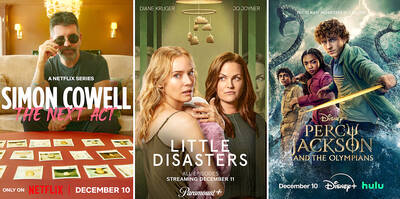My dream is to grow plants on buildings just as the human body grows hair," said Terunobu Fujimori, the architectural historian turned architect who grabbed Japanese media attention in the 1990s with a series of buildings that incorporated living plants.
The names of Fujimori's works -- Chive House, Dandelion House, Single Pine House -- pretty much say it all. Hundreds of pots of chives sway in the breeze on the slanting roof of a one-story cabin in Chive House while the roof of Single Pine House has a pine tree growing on it.

PHOTO:VICO LEE, TAIPEI TIMES
Photos of these and six other buildings by Fujimori in Japan, as well as four models of his architecture, are currently on show in Wildness in Architecture (野蠻建築展) at the National Culture Association (文化總會).

PHOTO COURTESY OF THE NATIONAL CULTURAL ASSOCIATION
For Fujimori, one of the key issues in 21st century civilization is the relationship between the natural and the manmade. His buildings, which incorporate nature, are meant to deal with the issue from a visual and aesthetic perspective.
In addition to his architecture, Fujimori is known for a series of award-winning essays collected in Adventures of Detective Architecture, published in the 1980s. It was the first series of architectural essays to become a national best-seller in Japan.
Convinced that artificial structures and elements in nature can reach a perfect harmony, Fujimori uses steel, mortar and industrial wood to build the inner structures and hidden elements of buildings while placing plants, soil and stone in the more visible locations.
The results are often houses of "ambiguous nationality" which appear naive or even surreal. He planted grass in a diagonal grid all over the roof of Camellia Castle, where a camellia is also planted.
"We often see plants on roofs of modern buildings, but they hardly ever blend in with the architecture. This is because rooftop gardens are usually designed by ecologists, who dislike artificial things. They would rather suppress the artificial to better express the plants," Fujimori said.
"But I think both the plants and the building have to look good. It's not easy, but I want them to get along well."
Apart from building private houses, Fujimori designed the Kumamoto Prefecture Agricultural University Student Dormitory using local timber. Independent pillars, a characteristic of Japanese wooden architecture, are used, but with a twist -- the rows of freestanding, undressed pine columns give people the illusion they're walking in a forest.
Fujimori admits that there are many limits to this incorporation of natural elements. "In Japan, most plants die in winter, so the houses can appear pretty only for a brief time. And when they grow too quickly, the house seems untidy. It takes a lot of work to make these buildings look nice," he said.
Plants in Taiwan, for example, may overwhelm the whole building into which they are integrated because they are "extremely strong".
Wildness in Architecture will show at the National Culture Association located at 15, Chungchin S Rd Sec 2 (

As I finally slid into the warm embrace of the hot, clifftop pool, it was a serene moment of reflection. The sound of the river reflected off the cave walls, the white of our camping lights reflected off the dark, shimmering surface of the water, and I reflected on how fortunate I was to be here. After all, the beautiful walk through narrow canyons that had brought us here had been inaccessible for five years — and will be again soon. The day had started at the Huisun Forest Area (惠蓀林場), at the end of Nantou County Route 80, north and east

Specialty sandwiches loaded with the contents of an entire charcuterie board, overflowing with sauces, creams and all manner of creative add-ons, is perhaps one of the biggest global food trends of this year. From London to New York, lines form down the block for mortadella, burrata, pistachio and more stuffed between slices of fresh sourdough, rye or focaccia. To try the trend in Taipei, Munchies Mafia is for sure the spot — could this be the best sandwich in town? Carlos from Spain and Sergio from Mexico opened this spot just seven months ago. The two met working in the

Exceptions to the rule are sometimes revealing. For a brief few years, there was an emerging ideological split between the Democratic Progressive Party (DPP) and Chinese Nationalist Party (KMT) that appeared to be pushing the DPP in a direction that would be considered more liberal, and the KMT more conservative. In the previous column, “The KMT-DPP’s bureaucrat-led developmental state” (Dec. 11, page 12), we examined how Taiwan’s democratic system developed, and how both the two main parties largely accepted a similar consensus on how Taiwan should be run domestically and did not split along the left-right lines more familiar in

A six-episode, behind-the-scenes Disney+ docuseries about Taylor Swift’s Eras Tour and Rian Johnson’s third Knives Out movie, Wake Up Dead Man, are some of the new television, films, music and games headed to a device near you. Also among the streaming offerings worth your time this week: Chip and Joanna Gaines take on a big job revamping a small home in the mountains of Colorado, video gamers can skateboard through hell in Sam Eng’s Skate Story and Rob Reiner gets the band back together for Spinal Tap II: The End Continues. MOVIES ■ Rian Johnson’s third Knives Out movie, Wake Up Dead Man